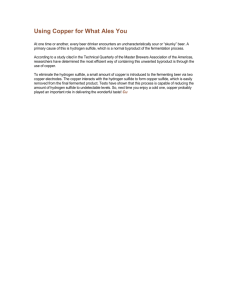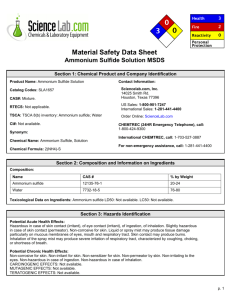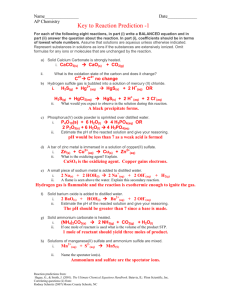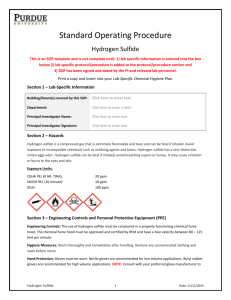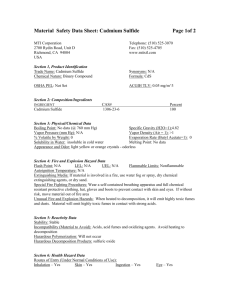8152 AMMONIUM SULFIDE, SOLUTION, LIGHT (English
advertisement
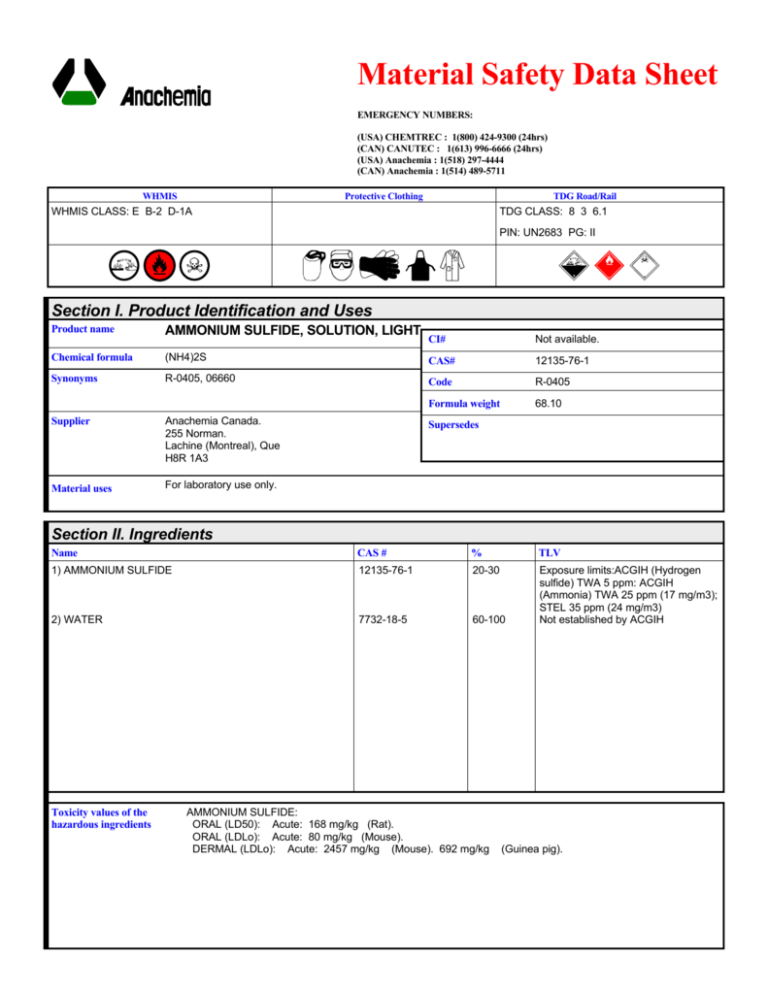
Material Safety Data Sheet EMERGENCY NUMBERS: (USA) CHEMTREC : 1(800) 424-9300 (24hrs) (CAN) CANUTEC : 1(613) 996-6666 (24hrs) (USA) Anachemia : 1(518) 297-4444 (CAN) Anachemia : 1(514) 489-5711 WHMIS Protective Clothing TDG Road/Rail WHMIS CLASS: E B-2 D-1A TDG CLASS: 8 3 6.1 PIN: UN2683 PG: II 3 Section I. Product Identification and Uses Product name AMMONIUM SULFIDE, SOLUTION, LIGHT CI# Not available. Chemical formula (NH4)2S CAS# 12135-76-1 Synonyms R-0405, 06660 Code R-0405 Formula weight 68.10 Supplier Anachemia Canada. 255 Norman. Lachine (Montreal), Que H8R 1A3 Material uses For laboratory use only. Supersedes Section II. Ingredients Name CAS # % TLV 1) AMMONIUM SULFIDE 12135-76-1 20-30 2) WATER 7732-18-5 60-100 Exposure limits:ACGIH (Hydrogen sulfide) TWA 5 ppm: ACGIH (Ammonia) TWA 25 ppm (17 mg/m3); STEL 35 ppm (24 mg/m3) Not established by ACGIH Toxicity values of the hazardous ingredients AMMONIUM SULFIDE: ORAL (LD50): Acute: 168 mg/kg (Rat). ORAL (LDLo): Acute: 80 mg/kg (Mouse). DERMAL (LDLo): Acute: 2457 mg/kg (Mouse). 692 mg/kg (Guinea pig). Section III. Physical Data AMMONIUM SULFIDE, SOLUTION, LIGHT Physical state and appearance / Odor pH (1% soln/water) Yellowish-orange fuming liquid. Sulfurous/ammoniacal odor. Odor threshold Not available. Percent volatile 100% (V/V) Freezing point Not available. Boiling point Not available. Specific gravity Not available. Vapor density 2.3 (Air = 1) Vapor pressure 450 mm of Hg (@ 20°C) Water/oil dist. coeff. Not available. Evaporation rate Not available. Solubility Miscible in water. page 2/4 >7 Section IV. Fire and Explosion Data Flash point CLOSED CUP: 22°C (AMMONIUM SULFIDE, 45% TECH.). Flammable limits LOWER: 4% (AMMONIUM SULFIDE) UPPER: 46% (AMMONIUM SULFIDE) Auto-ignition temperature Not available. Fire degradation products Oxides of sulfur and nitrogen. Ammonia. Hydrogen sulfide. Fire extinguishing procedures Use DRY chemical, alcohol-resistant foam or water spray. Do not use carbon dioxide. Wear adequate personal protection to prevent contact with material or its combustion products. Self contained breathing apparatus with a full facepiece operated in a pressure demand or other positive pressure mode. Move containing vessels from fire if without risk. Cool containing vessels with flooding quantities of water. Fire and Explosion Hazards Extremely flammable. Vapor may travel considerable distance to source of ignition and flash back, eliminate all sources of ignition. Vapor forms explosive mixture with air. Container explosion may occur under fire conditions or when heated. Contact with oxidizers may cause fire and/or explosion. Evolves highly toxic and flammable hydrogen sulfide gas on contact with acids. The sensitivity to impact is not available. Emits toxic fumes under fire conditions. Section V. Toxicological Properties Routes of entry Ingestion and inhalation. Eye contact. Skin contact. Skin absorption. Effects of Acute Exposure May be fatal by ingestion, inhalation or skin absorption. Corrosive. Hydrogen sulfide poisoning. Eye Causes severe burns and loss of vision. May cause permanent damage. Skin Causes severe burns. May be fatal if absorbed through the skin. Inhalation Highly toxic. Material is extremely destructive to tissue of the mucous membranes and upper respiratory tract. Inhalation may be fatal as a result of spasm, inflammation and edema of the larynx and bronchi, chemical pneumonitis and pulmonary edema. Symptoms of exposure may include burning sensation, coughing, laryngitis, dyspnea, headache, nausea, vomiting, dizziness, cyanosis, loss of consciousness and death. Concentrations of hydrogen sulfide above 500 ppm may cause headache, insomnia, nausea, sore throat, dizziness, drowsiness, and pulmonary edema. 600 ppm for 30 minutes can cause death. Ingestion Highly toxic. Burns in mouth, pharynx and gastrointestinal tract. Can cause nausea, vomiting, headache, cyanosis, respiratory depression, blood pressure fall, unconsciousness, tremors, convulsions, and death. Contact with gastric acids causes the formation of toxic hydrogen sulfide gas. See inhalation. Section V. Toxicological Properties Effects of Chronic Overexposure AMMONIUM SULFIDE, SOLUTION, LIGHT page 3/4 May cause conjunctivitis, hypotension, nausea, anorexia, loss of weight, chronic cough. Carcinogenic effects: Not available. Mutagenic effects: Not available. Teratogenic effects: Not available. Toxicity of the product to the reproductive system: Not available. To the best of our knowledge, the chemical, physical, and toxicity of this substance has not been fully investigated. Section VI. First Aid Measures Eye contact Immediate first aid is needed to prevent eye damage. IMMEDIATELY flush eyes with copious quantities of water for at least 15 minutes holding lids apart to ensure flushing of the entire surface. Seek immediate medical attention. DO NOT use an eye ointment. Skin contact Immediately flush skin with plenty of water for at least 15 minutes while removing contaminated clothing and shoes. Seek immediate medical attention. Wash contaminated clothing before reusing. Inhalation Remove patient to fresh air. Administer approved oxygen supply if breathing is difficult. Administer artificial respiration or CPR if breathing has ceased. Seek immediate medical attention. Ingestion If conscious, wash out mouth with water. Have conscious person drink several glasses of water to dilute. DO NOT induce vomiting. Seek immediate medical attention. Never give anything by mouth to an unconscious or convulsing person. Section VII. Reactivity Data Stability Stable. Conditions to avoid: High temperatures, sparks, open flames and all other sources of ignition, contamination. Hazardous decomp. products Not available. Incompatibility Acids, bases, oxidizing agents, potassium chlorate, sodium nitrite, metals (aluminum, zinc, copper, and their alloys, etc...), brass, bronze. Reaction Products Corrodes copper, zinc and their alloys. Contact with acids liberates toxic and flammable hydrogen sulfide gas. May explode on contact with zinc. Hazardous polymerization will not occur. Section VIII. Preventive Measures AMMONIUM SULFIDE, SOLUTION, LIGHT page 4/4 Protective Clothing in Wear self-contained breathing apparatus, rubber boots and heavy rubber gloves. case of spill and leak Spill and leak Evacuate the area. Eliminate all sources of ignition. Cover with DRY earth, sand or other non-combustible material. Use water spray to reduce vapors. Place in a suitable container and mark for disposal. Use non-sparking tools. Ventilate area and wash spill site after material pick up is complete. DO NOT empty into drains. DO NOT touch damaged container or spilled material. Runoff to sewer may create fire or explosion hazard. Waste disposal According to all applicable regulations. Harmful to aquatic life at low concentrations. Can be dangerous if allowed to enter drinking water intakes. Do not contaminate domestic or irrigation water supplies, lakes, streams, ponds, or rivers. Storage and Handling Store in a cool place away from heated areas, sparks, and flame. Store in a well ventilated area. Store away from incompatible materials. Do not add any other material to the container. Do not wash down the drain. Do not breathe gas/fumes/vapor/spray. In case of insufficient ventilation, wear suitable respiratory equipment. Keep away from direct sunlight or strong incandescent light. Keep container tightly closed and dry. Manipulate under an adequate fume hood. Take precautionary measures against electrostatic discharges. Ground the container while dispensing. Ground all equipment containing material. Use explosion proof equipment. Use non-sparking tools. Watch for accumulation in low confined areas. Empty containers may contain a hazardous residue. Hydrogen sulfide gas may accumulate to highly toxic levels in the head space of unopened containers. Handle and open container with care. Take off immediately all contaminated clothing. This product must be manipulated by qualified personnel. Do not get in eyes, on skin, or on clothing. Wash well after use. In accordance with good storage and handling practices. Do not allow smoking and food consumption while handling. In case of accident or if you feel unwell, seek medical advice immediately (show the label when possible.). May corrode metallic surfaces. Section IX. Protective Measures Protective clothing Face shield and splash goggles. Impervious gloves, apron, coveralls, and/or other resistant protective clothing. Sufficient to protect skin. A OSHA/MSHA jointly approved respirator is advised in the absence of proper environmental controls. If more than TLV, do not breathe vapor. Wear self-contained breathing apparatus. Do not wear contact lenses. Make eye bath and emergency shower available. Ensure that eyewash station and safety shower is proximal to the work-station location. Engineering controls Use process enclosures, local exhaust ventilation, or other engineering controls to keep airborne levels below recommended exposure limits. Use adequate ventilation. Do not use in unventilated spaces. Section X. Other Information Special Precautions or Corrosive! Highly toxic! Extremely flammable liquid! Risk of serious damage to eyes. comments Readily absorbed through skin. Stench. Do not breathe vapor. Avoid all contact with the product. Avoid prolonged or repeated exposure. Use in a chemical fume hood. Keep away from heat, sparks and flame. Take precautionary measures against static discharges. Use non-sparking tools. Contact with acids liberates toxic gas. Hydrogen sulfide gas may accumulate to highly toxic levels in the head space of unopened containers. Handle and open container with care. Container should be opened only by a technically qualified person. RTECS NO: BS4920000 (Ammonium sulfide (solution)). NFPA Prepared by MSDS Department/Département de F.S.. Validated 20-Nov-2012 Telephone# (514) 489-5711 While the company believes the data set forth herein are accurate as of the date hereof, the company makes no warranty with respect thereto and expressly disclaims all liability for reliance thereon. Such data are offered solely for your consideration, investigation and verification.


